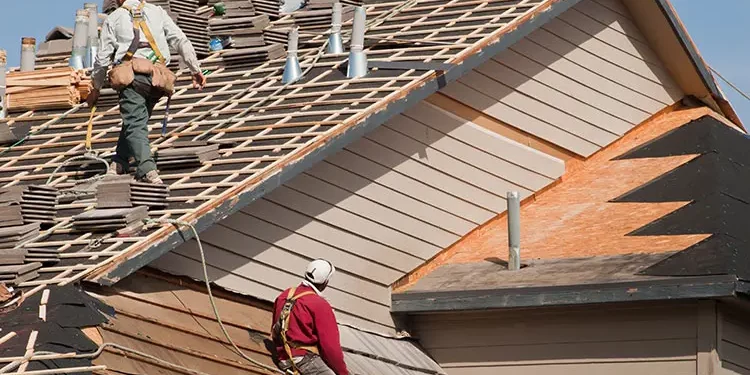Few things are more disheartening for homeowners than discovering hail damage on their roofs. The repercussions of hail can range from minor cosmetic issues to severe structural damage, necessitating a crucial decision: roof repair or complete replacement. In this comprehensive guide, we’ll delve into the intricacies of roof replacement, focusing on the impact of hail damage on costs and considerations.
Roof replacement is a pivotal decision, especially in the aftermath of hailstorms. Recognizing the signs of damage promptly is crucial. Dented shingles, cracked tiles, and granule loss are clear indicators that demand immediate attention. While some damage may be visible, the need for a professional inspection cannot be overstated. Let’s explore the journey from identifying hail damage to the ultimate decision of roof replacement.
Assessing Hail Damage
A. Identifying Visible Signs of Hail Damage
- Dented Shingles: Hail often leaves dents on shingles, compromising their integrity.
- Cracked or Broken Tiles: Severe hail can lead to cracks or complete breakage in roofing tiles.
- Granule Loss: Examine for granule loss, a sign of deteriorating shingle quality.
B. Hidden Damage and the Importance of Professional Inspection
- Checking for Structural Damage: Hail may cause hidden structural damage, affecting the roof’s stability.
- Assessing Damage to Underlayment: The underlayment is a crucial layer; any damage requires immediate attention.
- Evaluating Potential Water Leaks: Hail damage might create avenues for water infiltration, leading to further issues.
C. The Role of Insurance in Assessing Hail Damage
- The Claims Process: Understanding how to navigate insurance claims is vital for a smooth process.
- Documentation and Evidence Collection: Thorough documentation strengthens your case with insurance adjusters.
- Working with Adjusters: A collaborative approach with adjusters ensures fair evaluations of the damage.
Factors Influencing Replacement Costs
A. Size and Intensity of the Hailstorm
- Impact on Severity of Damage: Larger hailstones can result in more significant damage to roofing materials.
- Correlation with Repair Costs: Understanding the relationship between hail size and repair costs is essential.
- Case Studies of Different Hailstorms: Real-life examples provide insights into how various hailstorms impact replacement costs.
B. Roofing Material Considerations
- Asphalt Shingles: Popular but susceptible to hail damage; their replacement costs vary.
- Metal Roofs: More durable but may incur higher initial costs.
- Tile and Slate Roofs: Known for resilience, but replacement can be intricate and costly.
C. Geographic Location and Regional Cost Variations
- Climate Impact on Roof Longevity: Regions prone to hailstorms may experience more frequent roof replacements.
- Local Labor and Material Costs: The cost of replacement can significantly differ based on geographical location.
- Comparative Cost Analysis in Different Regions: Understanding regional variations helps in budgeting effectively.
Understanding Roofing Estimates
A. Breakdown of Typical Roofing Estimates
- Materials Cost: A significant portion of the estimate goes to the materials required for replacement.
- Labor Expenses: Skilled labor is crucial for a successful roof replacement.
- Additional Costs (Permits, Disposal, etc.): Ancillary costs need to be factored into the overall estimate.
B. Importance of Getting Multiple Quotes
- Variations in Pricing: Different contractors may provide varying estimates for the same scope of work.
- Ensuring Comprehensive Assessments: Multiple quotes ensure a thorough evaluation of the damage.
- Negotiating Effectively: Armed with multiple quotes, negotiate for the best deal without compromising quality.
C. Navigating Contract Terms and Warranties
- Clarifying Payment Schedules: Understand the payment structure outlined in the contract.
- Warranty Considerations: Knowing the warranty terms provides peace of mind post-replacement.
- Fine Print Awareness: Scrutinize the contract details to avoid surprises during and after the replacement process.
DIY vs. Professional Replacement
A. Risks and Benefits of DIY Repairs
- Cost Savings vs. Potential Pitfalls: DIY repairs may save money, but potential pitfalls should be considered.
- Suitability for Minor Damage: Small repairs may be suitable for a DIY approach.
- When to Consult Professionals: Major damage calls for professional expertise to ensure a thorough and lasting repair.
B. Professional Roofing Contractors
- Importance of Licensed and Insured Contractors: Choose professionals with the necessary credentials for a reliable outcome.
- Checking References and Reviews: Past performance indicators help in selecting a trustworthy contractor.
- Collaborating with Reputable Roofing Companies: Established companies often have a proven track record in quality roof replacements.
Case Studies of DIY Success and Failure Stories
- Learning from DIY Experiences: Understand the successes and failures of others for informed decision-making.
- Avoiding Common Pitfalls: Forewarned is forearmed – learn from the mistakes of DIY enthusiasts.
- Acknowledging the Limits of DIY Repairs: Recognizing when a professional touch is indispensable ensures a lasting solution.
Financing Options for Roof Replacement
A. Insurance Coverage Limitations
- Understanding Deductibles: Clarify the deductible amount and how it impacts the overall replacement cost.
- Policy Restrictions on Roof Replacement: Policies may have limitations; know them to avoid surprises.
- Supplementing Insurance with Other Financing Options: Explore additional financing avenues to cover costs not addressed by insurance.
B. Government Assistance Programs
- Federal and State Programs: Government programs may offer assistance; explore eligibility and benefits.
- Tax Incentives for Energy-Efficient Roofing: Some roofing materials may qualify for tax incentives.
- Researching Available Subsidies and Grants: Government and private grants can alleviate the financial burden of roof replacement.
C. Home Improvement Loans and Financing Plans
- Comparing Loan Options: Explore the variety of loans available for home improvement.
- Securing Favorable Interest Rates: A lower interest rate can significantly impact long-term repayment.
- Budgeting for Long-Term Repayments: Plan your finances to comfortably accommodate loan repayments.
Preventive Measures for Future Hail Damage
A. Choosing Impact-Resistant Roofing Materials
- Overview of Impact-Resistant Options: Consider materials designed to withstand hail impact.
- Long-Term Cost-Effectiveness: Initial costs may be higher, but durability translates to long-term savings.
- Balancing Aesthetics with Durability: Select materials that align with your aesthetic preferences without compromising durability.
B. Regular Maintenance Tips to Extend Roof Lifespan
- Cleaning Gutters and Drainage Systems: Proper drainage is essential to prevent water damage.
- Periodic Inspections: Regular inspections catch minor issues before they escalate.
- Prompt Repairs for Minor Damages: Addressing minor damages promptly prevents them from becoming major problems.
C. Investing in Protective Measures Like Hail Guards and Screens
- Assessing the Effectiveness of Hail Guards: Evaluate the effectiveness of protective measures.
- Installation Considerations: Proper installation ensures these measures perform optimally.
- Cost-Benefit Analysis: Weigh the costs of protective measures against potential hail damage expenses.
FAQs
1. Can minor hail damage be ignored?
Answer: While minor damage may seem inconsequential, it can worsen over time, leading to more significant issues. Prompt repairs prevent further deterioration and potential leaks.
2. Will insurance cover all replacement costs?
Answer: Insurance coverage varies. Review your policy to understand deductibles, limitations, and the extent of coverage. Supplemental financing may be needed for full replacement costs.
3. How often should roofs be inspected?
Answer: Regular inspections, at least annually, are recommended. After severe weather events like hailstorms, immediate assessments are crucial to catch and address damage promptly.
4. Are all hail damages visible immediately?
Answer: No, some damages may be hidden. Professional inspections are essential to identify structural and underlayment damage that may not be apparent at first glance.
5. Do I need to replace my entire roof if I have hail damage?
Answer: The extent of damage determines the need for full replacement. In some cases, partial repairs may suffice. Professional assessments guide the decision-making process.
6. Are roofing materials more resistant to hail damage?
Answer: Yes, impact-resistant materials like metal and certain types of shingles are available. Investing in these materials can mitigate the risk of hail damage.
7. Can I DIY roof replacement after hail damage?
Answer: While minor repairs may be manageable, full roof replacement is best left to professionals. DIY attempts can lead to mistakes and compromise the roof’s integrity.
8. How long does the roof replacement process take?
Answer: The duration varies based on factors such as the extent of damage, weather conditions, and the roofing material. Typically, it can take several days to a few weeks.
9. What financing options are available for roof replacement?
Answer: Insurance coverage, government assistance programs, and home improvement loans are common financing options. Explore what suits your financial situation and needs.
10. Can I install impact-resistant roofing on an existing roof?
Answer: In many cases, yes. Discuss options with a professional roofer to determine the feasibility and cost-effectiveness of upgrading your current roofing material.
Conclusion
In conclusion, navigating the aftermath of hail damage and the subsequent decision on roof replacement is a complex but crucial journey. Being informed about the various factors influencing costs and considerations is key to making sound decisions. Whether you choose to address minor damage with a DIY approach or opt for professional replacement, understanding the nuances of the process ensures a roof that stands the test of time. Regular maintenance and proactive measures contribute to the longevity of your investment, and being aware of available financing options eases the financial burden.
Remember, your roof is not just a shelter; it’s an investment in the longevity and safety of your home. By arming yourself with knowledge, you can make informed decisions that protect your home and provide peace of mind for years to come.







